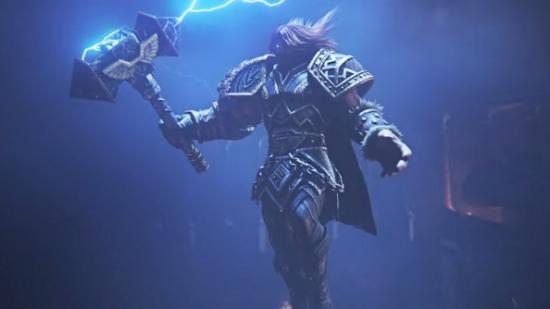Gods are a bit loopy. We envision them with magical powers, like the ability to shapeshift in an attempt to woo mortal women; they start wars because someone once said they weren’t very pretty; and they have parties that aren’t over until someone’s head gets ripped off.
They’ve become the stars of a MOBA, too. Smite pits deities from seven pantheons against each other in a game that mixes traditional MOBA elements with skill shots and third-person action.
Picking which gods make the cut and how to present them in-game seems like an arcane art, so I hit up lead designer Scott Zier to get the skinny on on Hi-Rez’s process; how the team pulls deities out of their crazy myths and manages to fit them into a game where everyone’s kicking the crap out of each other.
“We usually have several goals in mind when we start researching new gods,” Zier tells me. “Sometimes the goals are gameplay related, and sometimes they are to fill pantheon or personality gaps.”

Geb, the Egyptian god of earth was added to the roster for both reasons. Old Geb was the first divine king of Egypt and the father of Osiris – who you might know as the fella who got chopped up into wee pieces. He’s the sort of god you don’t want to tell a joke to, not because he doesn’t have a sense of humour, but because his laughter caused earthquakes.
“Before we selected Geb, we knew we needed to add a new Guardian to the roster that month, and that we wanted to introduce temporary health shielding into the game. We were also looking for a god that could be less human in appearance, to give a bit more diversity versus our recent releases. Geb happened to fulfill all of those desires, so it was an easy choice to add him into the schedule.”
The team doesn’t always add a new god because there’s a gap that needs to be filled, though. The Roman deity, Janus, found his way into Smite because, while researching gods, Hi-Rez realised that he could offer something new and interesting, If you’re not already down on your Roman god lore, Janus is the two-faced god of transitions – both literal and figurative. So he had a thing for physical doors, but also endings and beginnings.
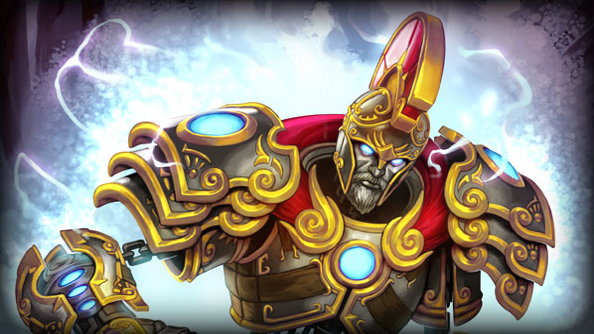
In Smite, his role in the pantheon was transformed into a powerset based on portals and movement. “Even though portals wasn’t something we went in looking for, the ideas and mechanics we started brainstorming earned him a spot on the roster,” says Zier.
Every god in Smite exists to fight. No matter what role they fulfill, they’ll be duking it out with other gods. But Hi-Rez doesn’t specifically look for angry, rage-fueled gods that are typically associated with war and battle. There are gods like that in Smite, of course, like Ares, the Greek god who loves war so much he made it his career, and Thor, the Norse god of thunder, who has never come across a problem he hasn’t wanted to fling a hammer at. In Smite, they fill the roles of tanky Guardian and damage-dealing Assassin, respectively.
But they are joined by the likes of Aphrodite, who is more of a lover than a fighter – though she certainly caused a lot of conflict. She also knocked boots with Ares, making a cuckold out of her hubby, the smith Hephaestus. The Greek pantheon would make a wonderful soap opera. Appropriately, Aphrodite has the Mage role, staying out of the fray, buffing her “soul mate”, an allied god that she’s targeted.
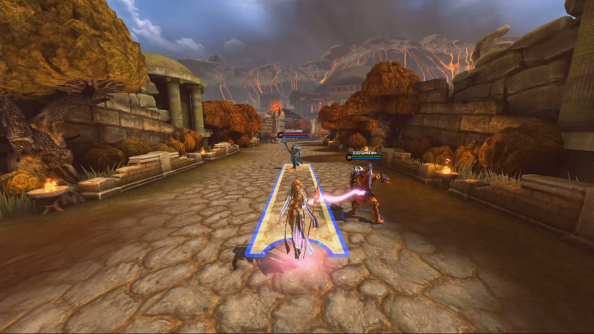
“Personality is very important to us, and certainly mythology influences our picks based on how we think the subject could be presented,” Zier explains. “I wouldn’t say we look for more aggressive deity’s per say, but rather we look for having a good range of personality options for our players.”
Turning these gods, with their big personalities and heapings of lore, into combatants involves the whole studio, but Zier notes that each deity has its own assigned designer.
“Each god has its own designer in charge of taking those ideas and bringing them together into a cohesive ability design. That original design is almost never the one we ship, but is a starting point for implementation and testing.
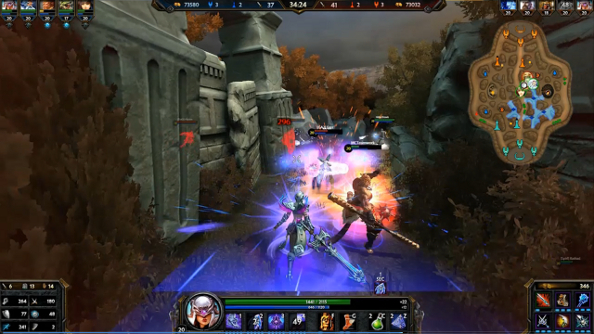
“We maintain a very agile work environment, and love to iterate quickly and frequently. If an initial idea doesn’t work, we toss it and start over. The only way to do that and meet our schedule is to get into testing as quickly as possible with roughs and basic block outs. For that, each god also has a dedicated programmer and modeler assigned, and a team of animators, riggers, and FX artists.”
Some of the deities have abilities that are pretty out there – like my personal favourite: Ah Muzen Cab. He’s the Mayan god of bees, and in the world of Smite, he looks like The Monarch from Venture Bros. and smears honey all over the battlefield while also plonking down hives of angry bees.
With deities like Ah Muzen Cab, Hi-Rez has a bit more freedom to create eccentric abilities, because the lore that surrounds them is less well known – they aren’t iconic. It’s not the same with Zeus, the head honcho of the Greek pantheon, for instance. People have expectations when they see Zeus. He should be a big, bearded fella who flings thunderbolts. They might not know that he also seduces women by turning into animals, like a swan, and was generally a bit of a sex pest – so you don’t see that side of him in Smite. That might be for the best.
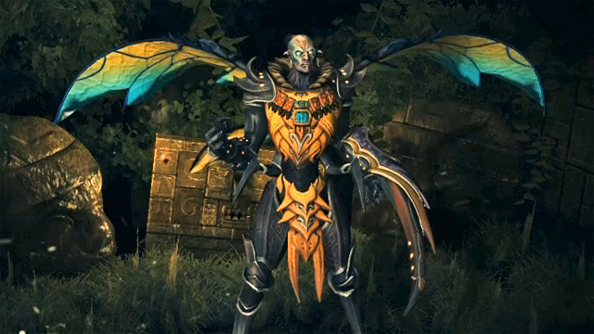
With gods being a reflection of human nature, the bad as much as the good, there’s no dearth of grim, miserable tales relating to them. Ancient deities could really be arseholes. But Smite’s generally pretty upbeat, bright and colorful. The gods being a bit cheeky is usually as far as it gets – there’s none of the sisyphean torment and no birds eating the entrails of Prometheus.
“Above all else, we want Smite to be fun,” says Zier. “I think we’ve found more enjoyment ourselves, and from our players, in keeping things less serious. We want to present the characters true to their lore, but do so in a way that our players can relate to and feel good about.
“Apollo is great example of this approach; his lore page is historically accurate and his ability design covers several key parts from his written exploits as God of Music and the sun… but he sounds like a British rock-star! That’s certainly not historically accurate, but from a personality standpoint we felt it conveyed who he was – a bit of a jerk, and very full of himself – better than it would if he just spoke Greek. It also helped to reinforce his musical theme.”
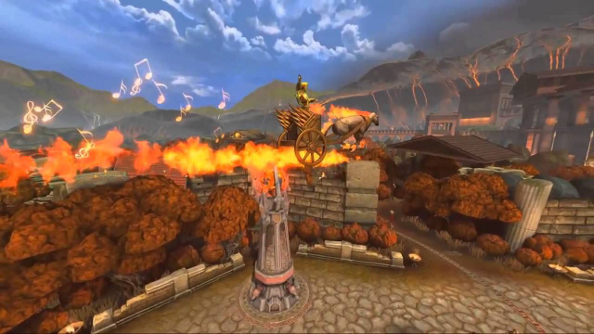
At the moment, Hi-Rez has seven pantheons to play with, and anything outside of those groups of gods is off limits. However, more pantheons are planned for the future. Within the current roster, the studio has occasionally run into a few problems though – particularly when it comes to Roman and Greek deities.
Simply: the Romans had sticky fingers when it came to mythology. Though, if we wanted to be nicer, we could say they were fans of interpretatio graeca. Many of the Roman deities were analogues of Greek ones, and Roman myth-makers inserted the origins of Rome into the Greek epic cycle – the myths relating to the Trojan War.
“There is a lot of crossover between those two pantheons,” Zier explains. “We often run into issues where, for example, we really want to do Hermes, but we have slotted another Roman god so we do Mercury instead. It kind of works out to be the same thing, but we often leave behind some big names as a result!”
Bloody Romans.
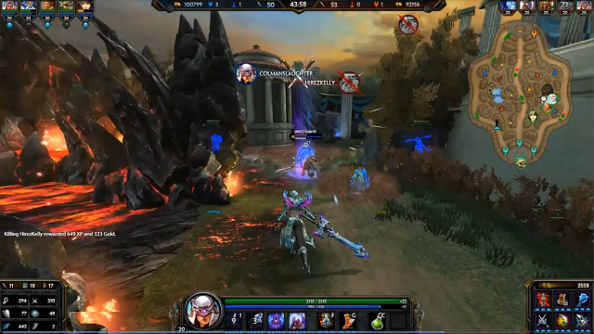
Some new things are in the works in regards to Smite’s own mythology too. The original set up for the game is quite threadbare. It’s a war between chaos and order, but everyone is fighting everyone else – there aren’t any actual fixed sides when it comes to the matches. In one match, Ra and Hades might be on the same team, but in another, they might be fighting each other. So there’s not a sense that there’s a cohesive story that impacts the battles or is impacted by them.
But Hi-Rez is hopefully going to make it clearer why these gods are so damn pissed off with each other. Not that the gods need much of an excuse – they do love their temper tantrums.
You can play Smite right now. It’s F2P, and a hoot. If you’re not sure if it’s your cup of divine tea, take a gander at my Smite review. I also put together a Smite beginner’s guide to get you started.
